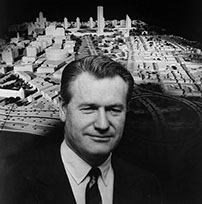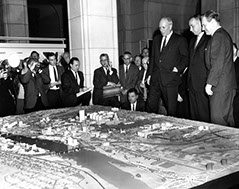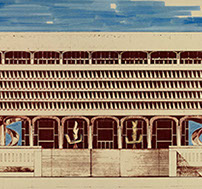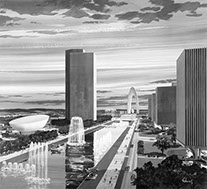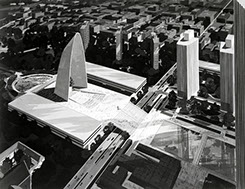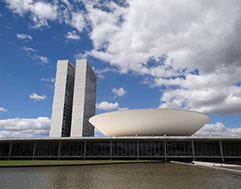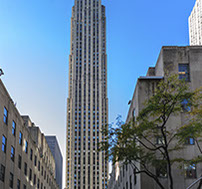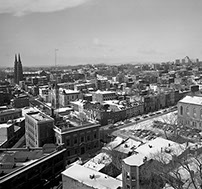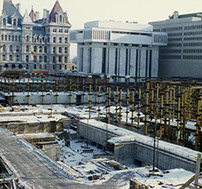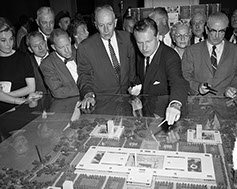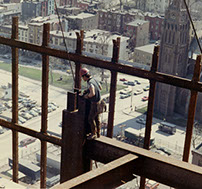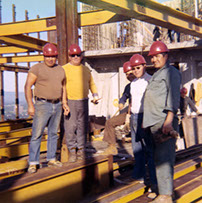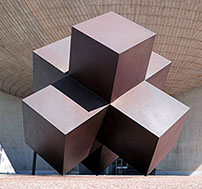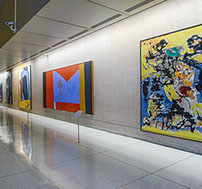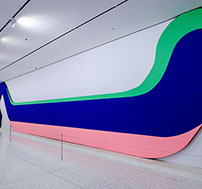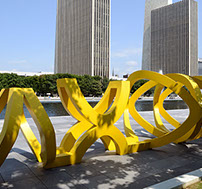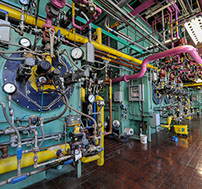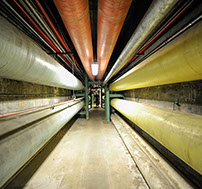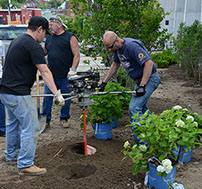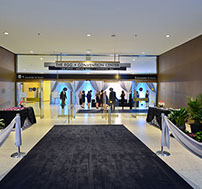In June 1965, the cornerstone was laid for what would become The Governor Nelson A. Rockefeller Empire State Plaza. Marketed at the time as a “Design for the Future,” the Plaza exists today as an icon of 20th century Modernist architecture. This exhibit commemorates the 50th anniversary of the Empire State Plaza and tells the story of how the center of New York’s capital city became a public space where government, culture, and community converge.
A Vision for Albany & Design for the Future
The Empire State Plaza exists because of the vision and determination of one man: Governor Nelson A. Rockefeller (1908–1979). The South Mall project would centralize the New York State’s expanding workforce into Albany’s city center, using large-scale modern architecture to demonstrate the state’s political and cultural importance.
Click images for more information
Architecture for the Modern World: The International Style
Click images for more information
The International Style emerged in the 1920s and 1930s, following the idea that a building’s design should come entirely from its purpose. With a surge in the growth of cities after World War II, the International Style was an achievable option for large urban development projects intended to boost the floor space for a given site. Most evident in the design of skyscrapers, the acceptance of industrialized mass-production techniques contributed to the International Style's design philosophy. Glass and steel, in combination with reinforced concrete, became primary construction materials. Architects who worked in the International Style broke with architectural tradition to design simple, unornamented buildings. Floor plans were functional and logical.
ARCHITECTURAL INFLUENCES
Inspiration for the grand scale and clean modern design of the Empire State Plaza came from several notable sources, including structures in nearby New York City and from two notable international architectural complexes built four centuries apart.Click images for more information
Capital City Under Construction
Construction of the Empire State Plaza began in 1965. For many years, the citizens of Albany watched the South Mall take form, emerging from a shapeless maze of deep foundations to become the dominant feature in the Albany skyline. The first building to be completed was the Legislative Office Building in 1972, and the last was the Egg in 1978.
Click images for more information
BOOMTOWN
More than 60 prime contractors and over 1,500 subcontractors and suppliers were employed by the state to build the Plaza. The newly formed New York State Office of General Services was assigned oversight of the project. During peak construction, as many as 2,500 people worked at the Plaza, most of whom were unionized workers. During this time, Albany was described as a “boomtown,” with construction on the Plaza drawing people from all over the country to answer the demand for specialized building trades that included: carpenters, bricklayers, electricians, ironworkers, operating engineers, painters, plasterers, glaziers, plumbers and steamfitters, roofers, sheet metal workers, pipe insulators, boilermakers, teamsters, elevator constructors, and laborers.Click images for more information
Construction in Albany was not limited to the Plaza during this time. The state was also heavily investing in infrastructure and education, building new highways, colleges, and universities. The new Dunn Memorial Bridge over the Hudson River, along with a highway bypass, connected travelers directly to the Plaza. Buildings were also going up across town at the W. Averell Harriman State Office Campus to centralize many of the state’s larger agencies.
Empire State Plaza Art Collection
The Empire State Plaza Art Collection has been heralded as “the greatest collection of modern American art in any single public site that is not a museum.” Beginning in 1965, following a procedure he established decades earlier during the construction of Rockefeller Center, Governor Nelson Rockefeller assembled a commission of art experts to select the works for the Plaza and personally signed off on each acquisition. Funds for the art purchases were allocated as a percentage of the construction cost of each building on the Plaza. There are 92 works in the collection; 90 of which were purchased and two gifted. Sixteen works were commissioned for specific sites on the complex. The collection includes noted artists Mark Rothko, Robert Motherwell, David Smith, Jackson Pollock, Helen Frankenthaler, Franz Kline, Louise Nevelson, and Alexander Calder.
Click images for more information
Behind the Scenes at the Plaza
On October 1, 1960, the New York State Legislature authorized the creation of the new state agency for the consolidation and management of core government support services. The Office of General Services, commonly known as OGS, was born. From the beginning, the care and management of the state’s office buildings was at the heart of OGS. While simultaneously bringing the state’s existing real property portfolio up to modern standards, OGS was assigned the oversight and development of the South Mall Project—one of the largest civic construction projects of the 20th century. Fifty years after Governor Rockefeller memorialized the laying of the Plaza’s cornerstone, OGS employees are still responsible for “keeping the lights on” here at the Plaza.
Click images for more information
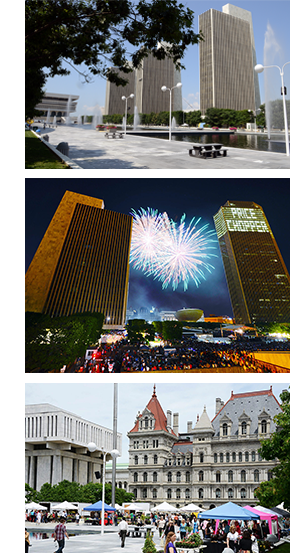 The Plaza Today
The Plaza Today
“Fifty years after Governor Rockefeller laid its cornerstone, the Empire State Plaza stands as a place where government and community converge. The Plaza offers a number of unique opportunities for visitors to learn more about our state’s history and culture, and I encourage New Yorkers and visitors alike to attend one of the many anniversary events taking place this summer and fall.”
— Governor Andrew M. Cuomo
"In the last 50 years, generations of families have played a part in the history of the Empire State Plaza. While the neighborhoods that were lost to build the Plaza can never be replaced, the Plaza has become a part of the community shared by all. From the tradespeople who constructed it and continue to maintain it, to state employees who spent their careers in its hallways, to those who come to the concerts, get engaged to be married on the ice rink, run in the road races that start here, ride the carousel at the State Museum, enjoy the fireworks on July 4, and join their neighbors each Thanksgiving Day to deliver meals, the Empire State Plaza is more than a government complex; it is part of their everyday life and family memories."
— New York State Office of General Services Commissioner RoAnn Destito





<

 |
 |
Office of Cultural Education New York State Education Department Information: 518-474-5877 Contact Us | Image Requests | Terms of Use |
